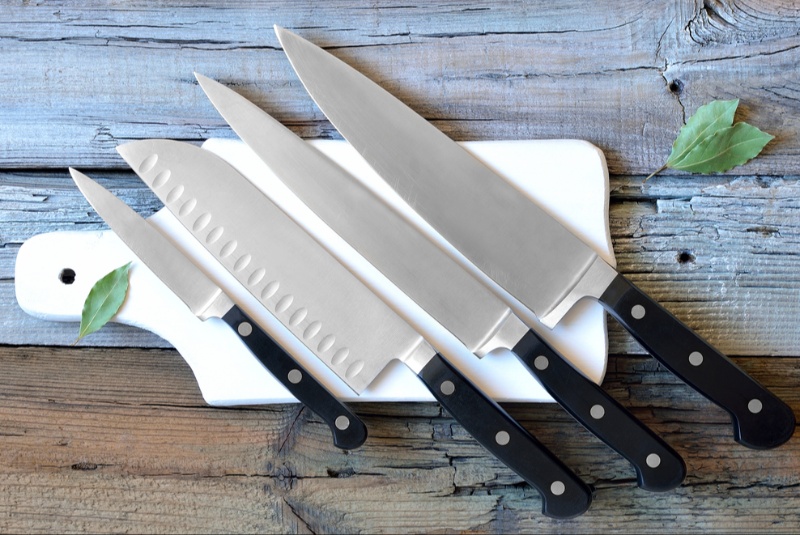Embarking on a journey as a culinary connoisseur requires the right tools, and a chef's knife is at the heart of every kitchen. This guide aims to empower you with smart choices for buying chef's knives, ensuring that your culinary experiences are elevated with precision, durability, and craftsmanship.
1. Understanding the Anatomy of a Chef's Knife: The Foundation of Culinary Mastery
Blade Types and Shapes
Familiarize yourself with different blade types and shapes. From versatile Western-style chef's knives to the precision of Japanese-style blades, understanding the nuances helps you choose a knife that aligns with your culinary preferences.
Choosing the Right Blade Length
Consider the blade length based on your cutting style and the tasks you frequently undertake. While an 8-inch chef's knife is a popular choice for its balance between agility and versatility, longer or shorter options may suit specific preferences.
2. Quality Steel: The Core Element of Exceptional Chef's Knives
High Carbon vs. Stainless Steel
Understand the differences between high carbon and stainless steel. High carbon steel offers exceptional sharpness and edge retention but requires more maintenance, while stainless steel is resistant to corrosion and staining.
Damascus and Pattern-Welded Blades
Explore the beauty and functionality of Damascus and pattern-welded blades. These techniques involve layering different types of steel, creating a visually stunning blade with enhanced strength and sharpness.
3. Achieving the Perfect Balance: Handle Design and Materials
Ergonomic Handle Design
Prioritize ergonomic handle designs that provide comfort during prolonged use. Handles made from materials like wood, composite, or synthetic materials offer different textures and grips to suit individual preferences.
Full Tang Construction
Opt for knives with full tang construction, where the blade extends through the handle. This design enhances the knife's balance and durability, ensuring that it can withstand the rigors of professional or home kitchens.
4. Grind Types: Tailoring Your Knife to Culinary Tasks
Understanding Grind Styles
Explore different grind styles, such as flat, hollow, or convex grinds. Each style has unique characteristics that affect cutting performance, edge stability, and ease of sharpening.
Single vs. Double Bevel Edges
Choose between single and double bevel edges based on your cutting preferences. Single bevel knives are often preferred for precision tasks like slicing sashimi, while double bevel knives are versatile for various cutting techniques.
5. Hardness and Edge Retention: Striking the Right Balance
Rockwell Hardness Scale
Consider the Rockwell hardness scale when evaluating knives. A higher hardness level generally indicates better edge retention, but it may also make the blade more susceptible to chipping if not handled with care.
Maintaining a Sharp Edge
Prioritize knives with excellent edge retention for reduced maintenance. A sharp edge enhances cutting precision and minimizes the effort required for various culinary tasks.

6. Tailoring to Culinary Styles: Japanese vs. Western Chef's Knives
Japanese Chef's Knives
Explore the precision and finesse of Japanese chef's knives. These knives often feature thinner blades, sharper angles, and unique profiles tailored to specific culinary tasks.
Western Chef's Knives
Embrace the versatility and robustness of Western-style chef's knives. With broader blades and slightly curved profiles, these knives excel in a wide range of kitchen tasks.
7. Budget Considerations: Finding Quality Within Your Means
Investing in Quality*
While chef's knives can vary in price, consider it an investment in your culinary journey. Quality knives, properly maintained, can last for years and significantly enhance your cooking experience.
Balancing Features and Budget*
Strike a balance between features and budget. Prioritize essential features that align with your cooking style while being mindful of your financial considerations.
8. Trying Before Buying: The Importance of Test Cuts
In-Store Testing*
Whenever possible, try knives in-store before making a purchase. Test the grip, weight, and balance to ensure that the knife feels comfortable and suits your cutting style.
Seeking Recommendations*
Seek recommendations from culinary professionals or knowledgeable individuals. Personal experiences and insights can guide you toward knives that have proven themselves in real kitchen scenarios.
9. Care and Maintenance: Prolonging the Life of Your Chef's Knife
Proper Storage Practices
Invest in a quality knife block, magnetic strip, or blade guard to protect your knife's edge. Avoid storing knives loosely in drawers, as this can lead to damage and accidents.
Regular Honing and Sharpening*
Incorporate regular honing and sharpening into your knife maintenance routine. Honing keeps the edge aligned, while sharpening ensures that the blade remains consistently sharp.
10. Building a Knife Set: Beyond the Chef's Knife
Essential Companions*
Consider additional knives to complement your chef's knife. Paring knives, utility knives, and serrated knives can fulfill specific tasks, creating a well-rounded set for diverse culinary needs.
Quality over Quantity*
Focus on quality over quantity when building your knife set. A few high-quality knives that meet your cooking needs are more valuable than a large set with redundant or lower-quality options.
Precision, Passion, and the Perfect Chef's Knife
The journey of a culinary connoisseur is intricately linked to the tools they wield, and the chef's knife stands as a testament to precision and passion in the kitchen. By understanding the nuances of blade types, materials, and design features, you can make smart choices that elevate your culinary craft. Whether you lean towards the artistry of Japanese knives or the versatility of Western designs, the perfect chef's knife is a harmonious extension of your culinary expression. Embark on your culinary adventures armed with knowledge, and let the perfect chef's knife become an indispensable companion in your pursuit of gastronomic excellence.




